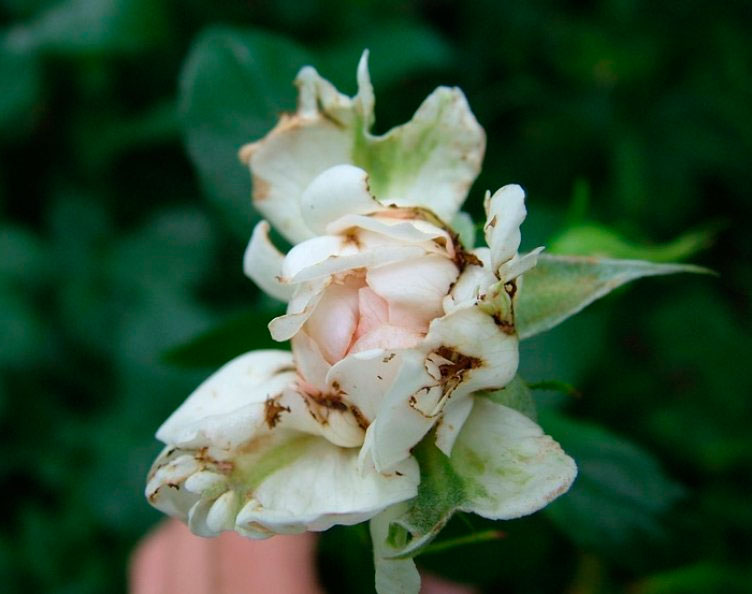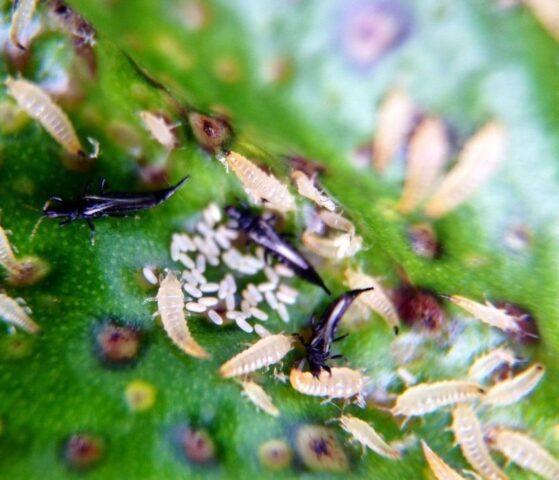Thrips are minute, sap-sucking insects—often less than 1 mm long—with slender bodies and fringed wings. They feed by puncturing plant cells and extracting their contents, causing silvery or bronze streaks on leaves and distorted or discolored buds and blooms. You may also spot tiny black specks (thrip excrement) on petals and foliage. Among the most common species attacking roses are the Western Flower Thrip (Frankliniella occidentalis) and the Rose Thrip (Thrips fuscipennis)
Decoding the Thrips Rapid Development
Thrips progress through a swift, incomplete metamorphosis, each stage thriving in warm, arid conditions. Females deposit eggs within the plant’s soft tissues, which soon hatch into hungry larvae that voraciously feed on foliage and flower buds. After their feeding phase, they drop to the ground or hide among decaying leaves to pupate. Mature adults then emerge to mate and continue the cycle. In high temperatures and low humidity, the entire sequence from egg to adult can take over your garden in as little as two weeks, and thrip numbers can increase dramatically if not addressed early.

Basic Prevention Strategies
Preventive treatments and the use of the methods listed below can significantly suppress thrips outbreaks:
Regular Monitoring & Deadheading
Walk your rose beds daily—especially in warm, dry weather—and deadhead any buds or blooms showing damage to interrupt the thrip lifecycle.
Maintain Humidity
Thrips thrive in dry conditions. A weekly mist or gentle spray of cool water on leaves deters them and dislodges existing nymphs.
Weed & Debris Control
Keep the area around rose bushes free of weeds and fallen foliage, which can harbor pupae and adults.
Reflective Mulches & Companion Planting
Installing reflective mulches (aluminum tape or foil) confuses thrips’ navigation, while planting marigolds or basil nearby can attract beneficial insects and repel thrips.
Soil Cultivation
Lightly loosen the soil around the base of plants to expose and destroy pupating thrips before they emerge.
Organic Thrips Control Methods
When you prefer to avoid synthetic chemicals, these organic options are highly effective:
Neem Oil
It acts as a repellent and disrupts thrip growth and reproduction. To protect beneficial insects, apply it in the early morning or late evening.
Insecticidal Soap
These soaps penetrate the thrip’s outer shell, causing dehydration and death. A homemade mix of 1 tbsp mild liquid soap per quart of water, thoroughly sprayed on buds and undersides of leaves, can knock down populations.
Beneficial Insects
Release minute pirate bugs (Orius spp.) or predatory mites (Phytoseiidae) to hunt thrips in foliage and soil stages.
Sticky Traps
Blue sticky cards among the roses can catch flying adults before they infest new growth.
Cinnamon Barrier
Sprinkling ground cinnamon around the plant base creates a natural deterrent and may disrupt thrip movement.

Get Your Free Lunar Gardener's Calendar 2025!
Join the Lunar Gardening Revolution! Subscribe now to receive our exclusive Free Lunar Gardener’s Calendar for 2025. Harness the power of the moon to optimize your planting, nurturing, and harvesting.
Expert Gardener Life Hacks
1.Rotate Control Strategies
Since thrips can develop resistance, switch between methods (e.g., neem oil one week, soap spray the next) to stay ahead of their defenses
2. Evening Garden Walks
A nightly stroll gives you a front-row seat to early thrip damage—when you catch them young, control is much easier.
3. Use of Flea Shampoo:
Some gardeners add a small amount of flea shampoo to insecticide sprays for enhanced effectiveness.
4. Double-Check New Plants
Before integrating them into your garden, inspect any new roses or nearby ornamentals for hidden infestations.

When to Use Chemical Insecticides
If organic methods fail to bring populations under control, consider targeted insecticides:
Spinosad
A reduced-toxicity option that kills adult thrips on contact and through ingestion.
Acephate
It is effective against chili thrips but can render blooms toxic to pollinators for up to ten days—use judiciously and according to label instructions.
Always apply systemic or contact insecticides before thrips enter closed buds and repeat applications every 7–10 days to target successive generations. Wear protective gear and avoid spraying during peak pollinator activity.
By blending careful monitoring, innovative cultural practices, and a toolkit of organic and, if necessary, chemical remedies, you can keep thrips at bay and enjoy healthy, vibrant roses all season long.
Frequently Asked Questions
1. How do I identify thrips on my roses?
Look for silvery or bronze streaks on petals and leaves, distorted or unopened buds, and tiny black specks of excrement on the surface. Thrips are around 1 mm long and slender and may flutter away if disturbed.
2. What organic treatments work best against thrips on roses?
Weekly neem oil applications disrupt thrip feeding and reproduction, while insecticidal soaps dehydrate exposed individuals. When applied correctly, both methods are safe for most beneficial insects.
3. Will thrips harm me or my pets?
No—thrips feed exclusively on plant cells and are not a threat to humans or animals. At most, they can deliver a mild, fleeting bite that feels like a tiny pinprick.
4. Can thrips develop resistance to treatments?
Yes. Over time, thrips can become less susceptible to the same insecticidal agents, which is why rotating between different control methods is crucial to long-term success.
5. How can I prevent thrips before they appear?
Maintain a clean garden by removing debris and spent blooms, walk your beds daily to spot early signs, and use companion plants and reflective mulches to deter thrips from settling in the first place.
Want more gardening tips? Subscribe to our newsletter for monthly advice straight to your inbox!



